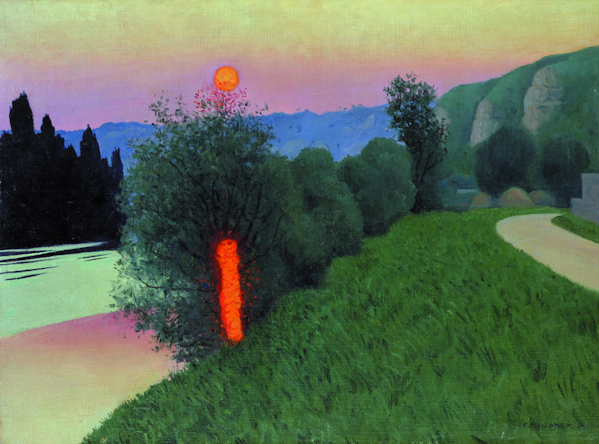
FelixVallotton|Soir aux Andelys, 1924
What is the Navier School?
💡A school that pursued order as a "painting
💡They sought neatness as a single plane rather than motifs or subjects.
💡Clear and beautiful forms and colors, without being concerned with realism
Characteristics of Navis School paintings and representative artists
1) Theorist Maurice Denis
The Navis School's view of art was opposed to Impressionism, which sought to capture the light of nature on the canvas, and pursued order in the painting itself. Among the group, Maurice Denis, known as a theorist Maurice Denis Maurice Denis, one of the group's leading theorists, stated, "A work of painting is a work of art.
"A work of painting is essentially a flat surface covered with colors collected in a certain order, before it is a nude, or a warhorse, or some other anecdotal object.
It was Denis who pursued the ideal of painting as painting, not as a substitute for something else.
It can be said that the Nabis school was a movement that began with history paintings, which had dominated Western art, passed through Impressionism, and then returned to religious paintings filled with symbolic meaning.
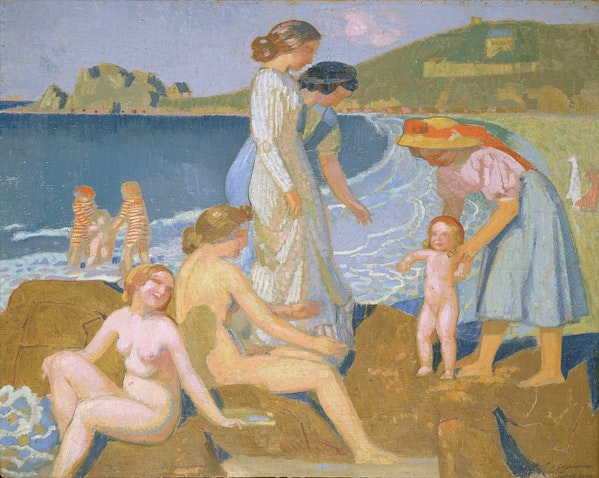
Maurice Denis, Women Bathing at Perros-Guirec, 1909, Museum Petit Palais, Paris
(2) Pierre Bonnard, Painter of Color
Pierre Bonnard, one of the most famous painters of the Navier School Pierre Bonnard Bonnard, one of the leading painters of the Navi School, said, "Painting is a series of small lies.
Painting is a series of small lies piled on top of each other to create a big truth.
Bonnard left many works with an excellent sense of color, not only in oil paintings, but also in posters and prints.
The main artists, including Denis and Bonnard, were strongly influenced by Cézanne and Japanese ukiyo-e prints in their compositions.
Their unique sense of color, which is different from both Western and Japanese art, but incorporates the best of both worlds, has made them very popular in Japan.

PierreBonnard|La Terrasse à Grasse, 1912
(3) Emile Bernard, Father of Croizonism
Born in Lille, France, Bernard moved to Paris on his own as early as age 10.
Through a chance encounter with Gauguin at Pont-Tavern and acquaintance with Van Gogh, Bernard became an advocate of the artistic movement known as Croizonism.
Croizonism is a style of painting characterized by thick black outlines and simple colors reduced to about seven colors.
.jpg?w=600&h=477)
Emile Bernard, Breton Women Playing in the Meadow, 1888.
Thus, the Navier School rejected the realism (realisme) that dominated the 19th century and asserted the mystique of art.
The path was prepared by their mentor Paul Gauguin as well as Odilon Redon as well as Georges Seurat and Georges Seurat.
Other Navis School painters
(4) Calm painting by Edouard Vuillard
Vuillard Vuillard's paintings tend to be more flat and decorative than those of the other Navis School painters.
He preferred to paint familiar subjects, such as interior scenes, and called himself an "Antimist" (Intimateist).
A lifelong bachelor, Vuillard never drank alcohol, and his paintings, with their austere color palette, are reminiscent of his gentle personality.
_-_Google_Art_Project.jpg?w=600&h=413)
Deux ouvrières dans l'atelier de couture, 1893
(5) Paul Selluzier, the founding head of the Navier School
Paul Selluzier was another important painter who brought Gauguin's ideas to Paris and became the center of the Naviste School.
Talisman" was created during a chance encounter with Gauguin at Pont-Tavern, Croisonisme and almost abstract.
In his later years, he immersed himself in theosophy, which brought a sense of religious sublimity back into the Parisian art world that had been modernized, urbanized, and flattened by the Impressionist painters. Theosophy is an occult field that later painters such as Piet Mondrian and Paul Klee were devoted to studying.
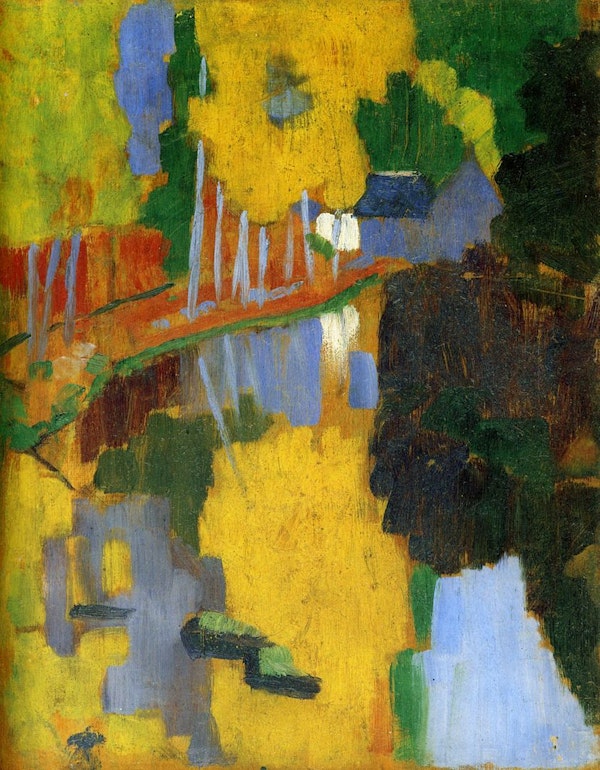
Paul Sérusier, Talisman, 1888, Musée d'Orsay
(6) Paul Ranson, religious artist
Paul Ranson is also a member of the Navier School.
He was a leader of the Nabis school along with Céluzier and Bonnard, but he was not a member of the other painters. Theosophy and the occult.
In his later years, his anti-priestly and mythological tendencies became more pronounced.
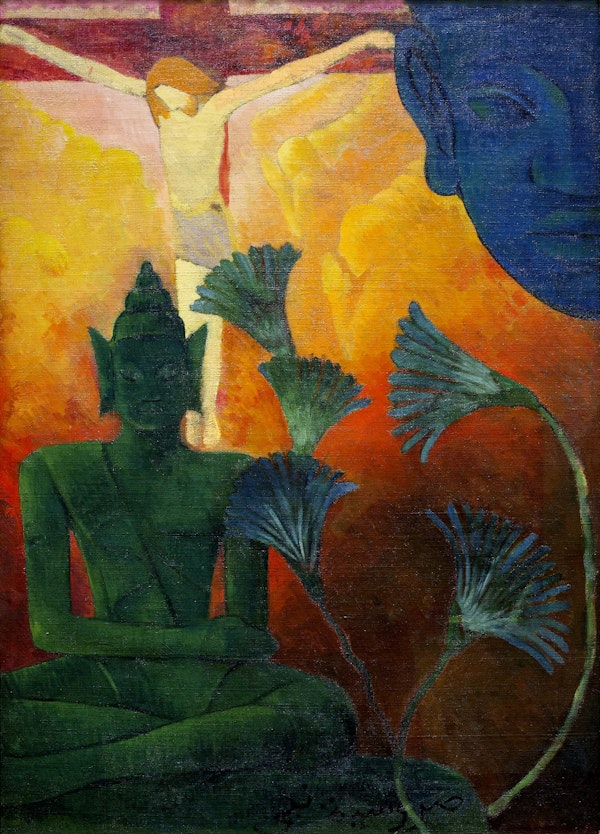
Paul Ranson, Christ and Buddha, 1880
(7) Felix Vallotton, painter of yin and yang
Felix Vallotton was a Swiss painter and printmaker.
While Selluzier and others first formed the Navier School within the Académie Julian, a community of art schools in Paris, Vallotton was one of the first painters to join from outside.
He created his own style, including woodblock prints, in a style that was clearly influenced by Post-Impressionism, Symbolism, and Japanese ukiyo-e prints.
The compositions, with their meaningful and explanatory elements, can be interpreted in a variety of ways by the viewer.
His compositions are based on dichotomous contrasting structures, such as yin and yang, light and dark, creating a style that can only be described as Vallottonian urbanization.
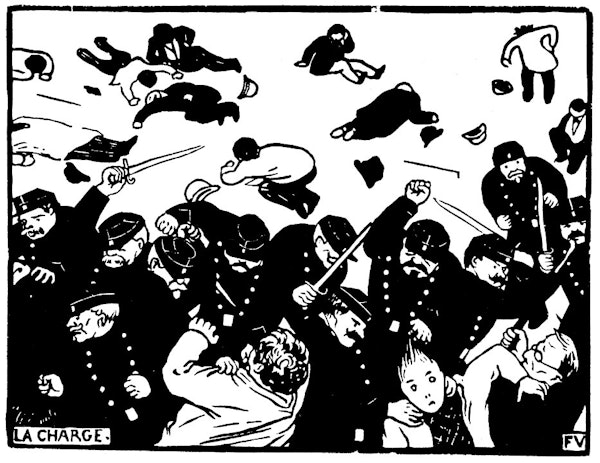
Felix Vallotton,La charge, 1893
8) Dutchman, Meijer de Haan
Born in the Netherlands Meijer de Haan He attended art school and exhibited at the Salon in his hometown despite his illness, but he felt he had reached his limits and left for Paris.
There he became friends with Theodorus van Gogh, an art dealer, and with his brother (later to become famous) Vincent van Gogh.
De Haan became friends with Gauguin in Pont-Tavern, where Gauguin left portraits and wood sculptures based on his motifs.
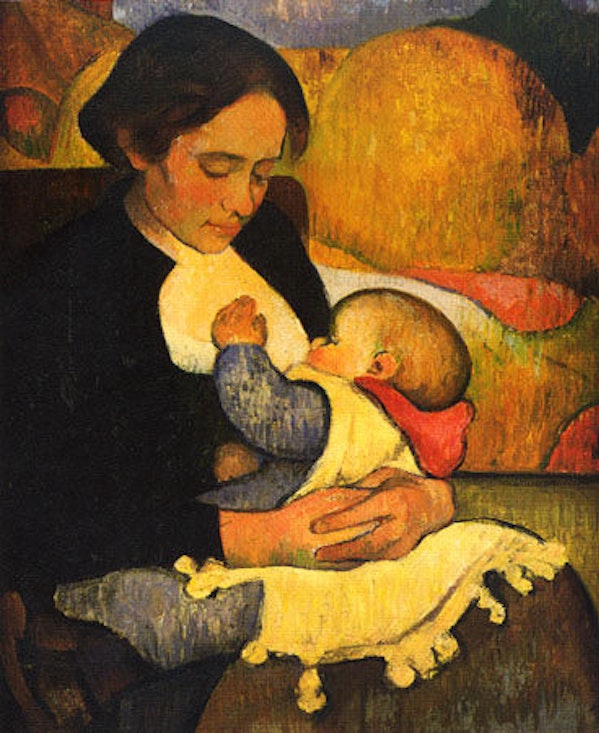
Maternité, Marie Henry allaitant son enfant, 1889
(ix) Georges Lacombe
Born into a wealthy family in Versailles Georges Lacombe met Emile Bernard and Paul Sérusier and became a member of the Navier School.
A painter by trade, Lacombe was also a vigorous sculptor, and was a member of the Navis School's sculpture team.
In particular, he formed a special friendship with Paul Ranson, with whom he collaborated on several projects, including the creation of a head for Ranson at the time of his death.
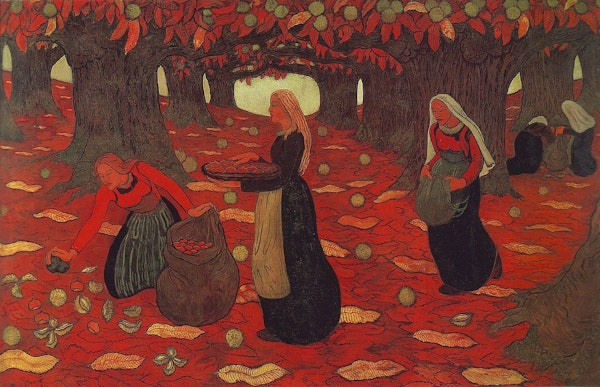
Automne, les Ramasseurs de noisettes, 1894
The Story of the Establishment of the Nabis School
The Navi School was a group of avant-garde artists active in Paris at the end of the 19th century. The word "Nabi" means "prophet" in Hebrew.
The birth of the Nabis came about in 1888, when the painter Paul Sereuzier, who was a student supervisor at the Académie Julian in Paris, visited Brittany and was mentored by Paul Gauguin.
When he and the young Sergeant went to sketch a forest, Gauguin advised him: "What color are those trees?
What color do those trees look like? Does it look a little reddish? Good, then put a bright red on the screen. And the shadow? It looks more bluish. Then put the most beautiful blue in your palette on the screen.
The bold use of color that Gauguin taught came as a shock to Celuzier, who had been taught accurate representation of the outside world at the Academy.
Céluzier took the night train back to Paris that day and shared Gauguin's teachings with his fellow Académie Julian students Pierre Bonnard, Édouard Vuillard, Maurice Denis, and Paul Ranson, who all agreed to form the Navi School group.
Later, young people from outside the Académie Julian, such as Gauguin's friend Aristide Maillol, Jan Verkade from the Netherlands, and Felix Vallotton from Switzerland, joined the group.
Also read
Post-Impressionism: Paintings No One Has Seen Before
Symbolism: To Hear the Silent Whisper of the Soul
Art Nouveau: The Revival of Decorative Arts
View the latest works of TRiCERA ART
TRiCERA ART members enjoy a variety of privileges and preferences.
- Discounts such as members-only secret sales and coupons
- Create your own collection by registering your favorite artists
- Receive updates on popular artists, exhibitions, and events
- Receive a weekly newsletter with selected art
- Personal Assessment to find out what kind of art you like.
Please register as a member for free and receive the latest information.
Free Member Registration